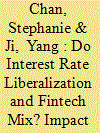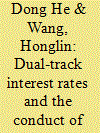| Srl | Item |
| 1 |
ID:
144856


|
|
|
|
|
| Summary/Abstract |
China's recent removal of the last ceiling restriction on deposit rates in October 2015 is a milestone in interest rate liberalization, but not the end of it. International experience suggests that, without structural and quantitative reforms, simply freeing interest rates can result in major financial stress. Before China's central bank can completely relinquish implicit or explicit guidance for commercial banks' interest rate determination, it needs to accomplish two tasks: improvement of commercial banks' pricing capability as well as the monetary policy transmission mechanism. Both tasks require significant reform measures to be initiated, such as enforcing market discipline, forming a new monetary policy framework, developing money and capital markets, abandoning quantitative restrictions on credit and reforming the financial regulatory system.
|
|
|
|
|
|
|
|
|
|
|
|
|
|
|
|
| 2 |
ID:
171878


|
|
|
|
|
| Summary/Abstract |
In this paper we attempt to characterize the stability of shadow deposits in China with interest rate liberalization and fintech developments. We emphasize that shadow banks provide higher but riskier returns and such characteristics affect the stability of shadow deposits. In our setting, the stability of shadow deposits is influenced by two offsetting effects, namely: the patience effect, which makes investors more willing to wait because of the potentially higher returns; and the uncertainty effect, which makes investors more likely to withdraw as a result of higher risk. Under liberalized interest rates, the patience effect will erode and the uncertainty effect will be heightened because the post‐liberalization higher return of traditional banks undermines the importance of the extra return of shadow deposits to depositors, while preserving the importance of the risk aspect. Fintech development is modeled as a reduction in the withdrawal cost that facilitates runs. This affects the stability of shadow deposits because of their wider fintech reliance. Regulators should be cautious in pushing interest rate liberalization and fintech application alongside building a safety net for shadow banking.
|
|
|
|
|
|
|
|
|
|
|
|
|
|
|
|
| 3 |
ID:
116515


|
|
|
|
|
| Publication |
2012.
|
| Summary/Abstract |
China has a dual-track interest-rate system: bank deposit and lending rates are regulated while money and bond rates are market-determined. The central bank also imposes an indicative target, which may not be binding at all times, for total credit in the banking system. We develop and calibrate a theoretical model to illustrate the conduct of monetary policy within the framework of dual-track interest rates and a juxtaposition of price- and quantity-based policy instruments. We show the transmission of monetary policy instruments to market interest rates, which, together with the indicative credit target in the banking system, ultimately are the means by which monetary policy affects the real economy. The model shows that market interest rates are most sensitive to changes in the benchmark deposit interest rates, significantly responsive to changes in the reserve requirements, but not particularly reactive to open market operations. These theoretical results are verified and supported by both linear and GARCH models using daily money and bond market data. Overall, the findings of this study help us to understand why the central bank conducts monetary policy in China the way it does, using a combination of price and quantitative instruments with differing degrees of potency in terms of their influence on the cost of credit.
|
|
|
|
|
|
|
|
|
|
|
|
|
|
|
|